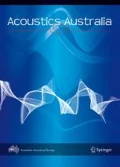Abstract
Speaking and listening are the primary modes of communication in the classroom. Therefore, optimal acoustic conditions are vital for children’s learning. The aim of this study was to assess the accuracy of the SoundOut Room Acoustics Analyzer iPad app developed by the National Acoustic Laboratories against a sound level meter. Forty-eight noise level measurements were compared in laboratory settings. Forty-six unoccupied ambient noise level recordings and 46 occupied background noise level recordings were taken in classrooms, as well as 64 reverberation time measurements. Strong positive correlations were found for the noise level comparison both in the laboratory and in classrooms. With all results combined, the maximum deviation on the measurements was 3 dB and the mean deviation was 0.8 dB. A strong positive correlation was also found between the SoundOut and sound level meter reverberation times. The maximum deviation was 0.03 s, and the mean deviation was 0.01 s. These results suggest that SoundOut can be an accurate tool for educators to measure the basic acoustic conditions of their classrooms. Future research is needed to evaluate the app on other Apple devices as well as assess between-iPad variability. The accessibility of this app, which negates the need for expensive specialised equipment, has the potential to help educators become more aware of the acoustic conditions of their classrooms. The app also gives suggestions on how to improve the acoustic conditions of classrooms which could help facilitate the process of implementing improvements and doing before and after testing to assess effectiveness.






References
American Speech-Language-Hearing Association: Acoustics in Educational Settings: Technical Report., (2005)
Rosenberg, G., et al.: Improving classroom acoustics (ICA): a three year FM sound- field classroom amplification study. J. Educ. Audiol. 7, 8–28 (1999)
Shield, B.M., Greenland, E.E., Dockrell, J.E.: Noise in open plan classrooms in primary schools: a review. Noise Heal. 12(49), 225–234 (2010)
Anderson, K.: Kids in noisy classrooms: What does the research really say? J. Educ. Audiol. 9, 21–33 (2001)
Shield, B.M., Dockrell, J.E.: The effects of noise on children at school: a review. Build. Acoust. 10(2), 97–116 (2003)
Klatte, M., Hellbruck, J.: Effects of classroom acoustics on performance and well- being in elementary school children: a field study. Environ Behav 42, 1–9 (2010)
Klatte, M., Lachmann, T., Meis, M.: Effects of noise and reverberation on speech perception and listening comprehension of children and adults in a classroom-like setting. Noise Health. 12(49), 270–282 (2010)
Braat-Eggen, E., Kohlrausch, A., Hornikx, M.: Writing performance in open-plan study environments: a laboratory study. In: 12th ICBEN Congress on Noise as a Public Health Problem, pp. 1–7. (2017)
Hurtig, A., Sörqvist, P., Ljung, R., Hygge, S., Rönnberg, J.: Student’s second-language grade may depend on classroom listening position. PLoS ONE 11(6), e0156533 (2016)
Dockrell, J.E., Shield, B.M.: Acoustical barriers in classrooms: the impact of noise on performance in the classroom. Br. Educ. Res. J. 32(3), 509–525 (2006)
Wang, L.M.: The impact of building acoustics on speech comprehension and student achievement. In: Proceedings of the 43rd International Congress on Noise Control Engineering (inter.noise), (2014)
Shield, B.M., Dockrell, J.E.: The effects of environmental and classroom noise on the academic attainments of primary school children. J. Acoust. Soc. Am. 123(1), 133–144 (2008)
Gotaas, C., Starr, C.D.: Vocal fatigue among teachers. Folia Phoniatr. (Basel) 45(3), 120–129 (1993)
Crandell, C.C., Smaldino, J.J.: Classroom acoustics for children with normal hearing and with hearing impairment. Lang. Speech. Hear. Serv. Sch. 31, 362–370 (2000)
Finitzo-Hieber, T., Tillman, T.W.: Room acoustics effects on monosyllabic word discrimination ability for normal and hearing-impaired children. J. Speech Hear. Res. 21(3), 440–458 (1978)
Australia/New Zealand Standard: AS/NZS2107:2016 Acoustics—Recommended design sound levels and reverberation times for building interiors. (2016)
Australia/New Zealand Standard: AS/NZS2107:2000 Acoustics—Recommended design sound levels and reverberation times for building interiors. (2000)
ISO 3382-2:2008(E). International Standard: Acoustics—Measurement of room acoustic parameters-Part 2: Reverberation time in ordinary rooms. (2008)
Acknowledgements
I would like to acknowledge Jorg Buchholz and Dan Zhou, the creators of the app. I would like to thank Greg Stewart and Elizabeth Beach for their help with this study. I would also like to thank the school teachers and children for allowing me to take measurements in their classrooms. This research is funded by the Australian Government through the Department of Health.
Author information
Authors and Affiliations
Corresponding author
Additional information
Publisher's Note
Springer Nature remains neutral with regard to jurisdictional claims in published maps and institutional affiliations.
Rights and permissions
About this article
Cite this article
Mealings, K. Validation of the SoundOut Room Acoustics Analyzer App for Classrooms: A New Method for Self-Assessment of Noise Levels and Reverberation Time in Schools. Acoust Aust 47, 277–283 (2019). https://doi.org/10.1007/s40857-019-00166-1
Received:
Accepted:
Published:
Issue Date:
DOI: https://doi.org/10.1007/s40857-019-00166-1

